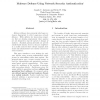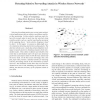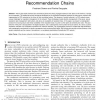912 search results - page 100 / 183 » Techniques for Securing Networks Against Criminal Attacks |
IWIA
2005
IEEE
15 years 3 months ago
2005
IEEE
Malware defenses have primarily relied upon intrusion fingerprints to detect suspicious network behavior. While effective for discovering computers that are already compromised,...
139
click to vote
IPPS
2006
IEEE
15 years 3 months ago
2006
IEEE
Selective forwarding attacks may corrupt some missioncritical applications such as military surveillance and forest fire monitoring. In these attacks, malicious nodes behave like...
CORR
2010
Springer
14 years 10 months ago
2010
Springer
With the discovery of new exploit techniques, novel protection mechanisms are needed as well. Mitigations like DEP (Data Execution Prevention) or ASLR (Address Space Layout Random...
TKDE
2010
14 years 8 months ago
2010
—Peer-to-peer (P2P) networks are vulnerable to peers who cheat, propagate malicious code, leech on the network, or simply do not cooperate. The traditional security techniques de...
119
click to vote
ICNP
2009
IEEE
14 years 7 months ago
2009
IEEE
Sensor networks deployed in hostile areas are subject to node replication attacks, in which an adversary compromises a few sensors, extracts the security keys, and clones them in a...




